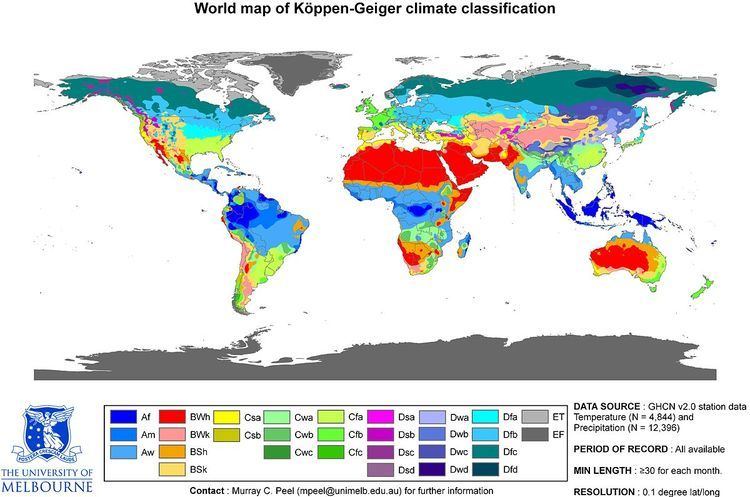 | ||
Continental climates are defined in the Köppen climate classification as having a coldest month mean temperature below -3 C (26.6 F) or 0 °C depending on which isotherm used for the coldest month and four months above 10 °C. In the Köppen climate system, Continental climates were bordered to the south by Temperate climates or C climates (coldest month above 0 C, but below 18 C) and to the north by Boreal climate or E climates (only 1 to 3 months with a mean temperature of 50 F). Köppen also defined continental climates as having more than 30 days with continuous snowcover on the ground.
Contents
- Spring and autumn
- Kppen climate classification
- Climatology
- Neighboring climates
- North America
- South America
- Europe
- Africa
- Middle East
- Asia
- Oceania
- References
Continental climates often have a significant annual variation in temperature (hot summers and cold winters). They tend to occur in the middle latitudes (40 to 55 north), where prevailing winds come from over land, and temperatures are not moderated by bodies of water such as oceans or seas. Continental climates occur mostly in the Northern Hemisphere which has the large landmasses required for this type of climate to develop. Most of northern and northeastern China, eastern and southeastern Europe, and the central and upper eastern United States have this type of climate.
In Continental climates, Precipitation tends to be moderate in amount, concentrated mostly in the warmer months. Only a few areas, in the mountains of the Pacific Northwest of North America and in Iran, northern Iraq, adjacent Turkey, Afghanistan, Pakistan, and Central Asia show a winter maximum in precipitation. A portion of the annual precipitation falls as snowfall, and snow often remains on the ground for more than a month. Summers in continental climates can feature thunderstorms and frequent cool temperatures, however summer weather is more stable than winter weather.
Spring and autumn
The timing of intermediate spring-like or autumn-like temperatures in this zone vary depending on latitude and/or elevation. For example, spring may arrive as soon as early March in the southern parts of this zone, or as late as May in the north. Annual precipitation in this zone is usually between 600 millimetres (24 in) and 1,200 millimetres (47 in), most of it in the form of snow during winter. It also has cold winters and warm summers.
Köppen climate classification
Most such areas fit Köppen classifications of Dfa, Dwa (cold winters, hot summers; "w" indicating very dry winters characteristic especially of China) or Dfb or Dwb (cold winters, warm summers, same distinction for winter dryness). Dry summer continental climates (Dsa and Dsb) exist in high altitude areas near Mediterranean climates. In some cases, the semi-arid climate classification of BSk can also be considered to be continental as long it has cold winter. The definition of this climate regarding temperature is as follows: the mean temperature of the coldest month must be below −3 °C (26.6 °F) and there must be at least four months whose mean temperatures are at or above 10 °C (50 °F). Some climatologists use the 0 °C isotherm instead for the coldest month.
Climatology
Continental climates exist where cold air masses infiltrate during the winter and warm air masses form in summer under conditions of high sun and long days. Places with continental climates are as a rule either far from any moderating effects of oceans (examples: Omaha, Nebraska and Kazan, Russia) or are so situated that prevailing winds tend to head offshore (example: Boston, USA). Such regions get quite warm in the summer, achieving temperatures characteristic of tropical climates but are colder than any other climates of similar latitude in the winter.
Neighboring climates
These climates grade off toward subtropical climates equator-ward where winters are less severe and semiarid climates where precipitation becomes inadequate for tall-grass prairies. In Europe these climates may grade off into oceanic climates in which the influence of moderating air masses is more marked toward the west. The subarctic climate (Köppen: Dfc), with very cold, long and dry winters, but with at least one month above 10 °C (50 °F), might be considered a sub-type of the continental climate.
